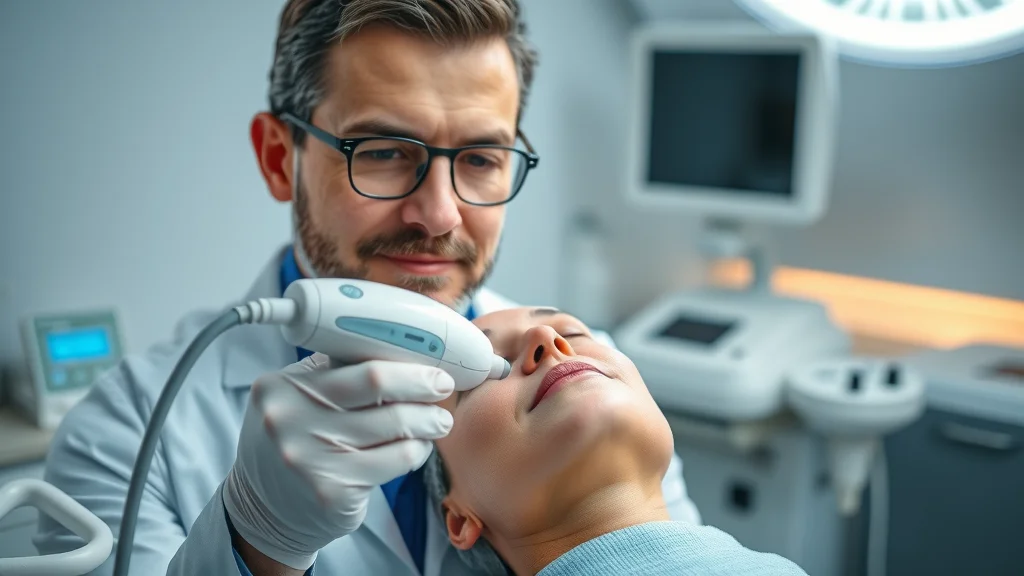Did you know: some non-surgical facelifts can keep your skin noticeably tighter and more youthful for as long as two years? With ultrasound facelift and thread lift procedures challenging the need for traditional cosmetic surgery, people seeking facial rejuvenation want to know which option truly stands the test of time. Let's explore how these modern facial lift innovations stack up, and help you make the most informed choice for lasting skin tightening and confidence.
Discover the Surprising Longevity of Ultrasound Facelift: Setting the Stage
“Did you know that some non-surgical facelifts can maintain results for up to two years? Advances like the ultrasound facelift are challenging what we thought we knew about facial rejuvenation.”
If you're considering a facial lift but want to avoid the risks and downtime of cosmetic surgery, noninvasive procedures like the ultrasound facelift and thread lift may be at the top of your list. With growing demand for treatments addressing skin laxity, it's critical to compare not only their immediate effects, but most importantly—how long their results actually last. Here, we put the spotlight on these two advanced cosmetic procedures, focusing on their real-world durability, ideal candidates, aftercare commitment, and the future of non-surgical facial rejuvenation.
What You’ll Learn About Ultrasound Facelift vs Thread Lift Durability
Gain insight into the effectiveness and durability of ultrasound facelift and thread lift procedures
Understand the core differences in technology, technique, and results
Learn about real-world longevity, side effects, and ideal candidates based on expert opinion
Compare costs, aftercare, and outcome expectations for both approaches

Understanding Ultrasound Facelift Technology: Focused Ultrasound and How It Works
Defining Ultrasound Facelift: Modern HIFU Facial Approaches
The ultrasound facelift, sometimes called HIFU facial or high-intensity focused ultrasound facial, harnesses advanced ultrasound technology to stimulate natural collagen production deep under your facial skin. Unlike traditional cosmetic surgery, this noninvasive procedure uses precise, targeted energy to initiate the body's restorative powers, gradually smoothing wrinkles and tightening sagging skin without anesthesia, stitches, or downtime. In recent years, flagship treatments like Ultherapy Prime have set the standard for safe and effective skin tightening—making the ultrasound facial a sought-after choice among people of varying skin tones and ages. Because this approach delivers results from the inside out, it can offer a natural lift and firmer contour while avoiding the risks involved in surgical alternatives.
What sets these modern HIFU facials apart is their ability to reach the deeper layers of the skin—typically targeted in surgical facelifts—without disrupting the surface. FDA-cleared devices, operated by licensed physicians, ensure treatment is both effective and controlled. Treatment sessions are usually quick, and most people notice a lifting effect over the following weeks as their skin's support structure is rebuilt. Thanks to its noninvasive nature, the ultrasound facelift is often recommended for those who wish to address early to moderate signs of aging like skin laxity, but aren't ready for more aggressive interventions.
Inside Focused Ultrasound and Intensity Focused Ultrasound
At the heart of the ultrasound facelift is focused ultrasound energy—specifically intensity focused ultrasound (IFU)—which is designed to bypass the surface and deposit energy precisely into the skin’s foundational layers. This process triggers the body’s own healing response, prompting cells to produce fresh collagen for firmer, smoother skin. Devices like Ultherapy and other HIFU platforms are engineered to deliver measured heat to specific depths, ensuring the safest and most predictable results with every session.
Compared to broad, less-controlled energy-based options, focused ultrasound allows for a tailored approach, which can be adapted to your skin type and the degree of skin laxity present. Some treatment protocols even combine HIFU facials with other modalities for enhanced outcomes. Ultimately, this technology offers an impressive middle ground—bridging the gap between mildly effective creams and the dramatic changes promised by surgical facelifts, while minimizing side effects and downtime.

How Ultrasound Facial Targets Skin Laxity and Skin Tightening
Addressing skin laxity—the gradual loss of firmness and elasticity—is a top concern for anyone seeking a facial lift. The power of the ultrasound facial is its ability to zero in on those deeper skin layers where collagen is most crucial. As the ultrasound energy heats targeted tissues, the body reacts by remodeling and rebuilding collagen fibers. Over time, patients will notice their facial skin becoming more lifted and defined, with smoother lines and less sagging, making this a highly effective option for noninvasive skin tightening.
Significantly, the ultrasound skin tightening process is well-suited for a variety of skin types and tones, as the energy bypasses pigmentation and doesn’t affect the outer skin layer. Many candidates appreciate that aftereffects such as redness or swelling tend to be mild and short-lived, with most able to return to regular routines quickly. Most importantly, scientific evidence and real-world patient satisfaction surveys highlight a duration of effects—sometimes 12 to 24 months—uncommon for other noninvasive facial lift methods.
Thread Lift Procedures: Methods, Mechanism, and Longevity
How Thread Lifts Address Skin Laxity and Achieve Skin Tightening
Often called the "lunchtime lift," a thread lift represents another innovative, non-surgical answer to addressing skin laxity and enhancing facial contours. In this cosmetic procedure, a specialist inserts dissolvable threads just beneath the skin's surface using a fine needle. These threads physically lift sagging skin while also provoking a targeted healing response, boosting natural collagen production along their path. The immediate result is a subtly lifted appearance—often visible right after the procedure—with further tightening and smoothing over weeks as collagen builds up.
Unlike the ultrasound facelift, which works exclusively via energy-induced tissue regeneration, the thread lift provides both mechanical support and biological stimulation in one session. New advancements in thread materials and techniques mean side effects are often temporary, including minor swelling, bruising, or tenderness. Importantly, thread lifts work best for mild to moderate sagging, especially in the cheeks, jowls, or brows, and are often considered a bridge for those not quite ready for or wanting to delay cosmetic surgery.

Materials Used and What to Expect from Cosmetic Surgery Alternatives
Thread lifts rely on medical-grade, dissolvable materials such as polydioxanone (PDO), polylactic acid (PLA), or polycaprolactone (PCL). These biocompatible threads are securely anchored beneath the skin and gradually absorbed by the body—typically over a period of 6 to 12 months—leaving behind a matrix of new collagen for added support. Because no incisions are required and only tiny entry points are made, downtime is brief in comparison to traditional cosmetic surgery.
Results from thread lifts can last anywhere from six months to a year, with peak results seen after the initial collagen boost. However, if you're hoping for subtle results that maintain a natural expression and avoid "pulled" appearances, the thread lift offers a personalized, minimally invasive alternative to surgical lifts. It's worth noting, however, that those with more pronounced skin laxity, or significantly heavier skin, may find the ultrasound facelift or even surgical options more appropriate for their goals.
Comparing Results: Which Lasts Longer—Ultrasound Facelift or Thread Lift?
Feature |
Ultrasound Facelift (HIFU/Ultherapy) |
Thread Lift |
|---|---|---|
Duration of Results |
12–24 months (sometimes longer with aftercare) |
6–12 months (depends on thread type and skin laxity) |
Procedure Time |
30–90 minutes |
30–60 minutes |
Recovery |
Minimal (some redness, swelling for few hours) |
Minimal to moderate (mild swelling, bruising, or tenderness for a week) |
Ideal Skin Type |
Most skin types, mild to moderate laxity, safe for diverse skin tones |
Lighter sagging, not for heavy/lax skin, ideal for early signs of aging |
Side Effects |
Redness, tingling, slight swelling, rare nerve effects |
Bruising, mild infection risk, thread visibility/puckering, swelling |
Ultherapy Prime and Other Ultrasound Treatment Advancements
The rapid evolution of non-surgical facelifts owes much to the technological leap in devices like Ultherapy Prime, which brings enhanced precision and comfort to the ultrasound facial space. With improved imaging and targeted ultrasound energy delivery, these devices can customize treatments to the unique density and thickness of each patient's skin, building on the safety and efficacy of earlier platforms. Ultherapy Prime especially stands out for its FDA clearance and reputation among licensed physicians for excellent outcomes with minimal side effects.
What’s more, as ultrasound treatment protocols improve, the duration and predictability of results continue to climb. Some clinics combine focused intensity focused ultrasound with other therapies for a truly comprehensive approach to facial rejuvenation. Modern ultrasound facelifts are now widely recognized as a safe and effective alternative for patients who prioritize minimal downtime and natural-looking results.

Key Factors Influencing Longevity: Age, Skin Type, and Aftercare
The actual longevity of either a ultrasound facelift or a thread lift depends on several individual factors. Age, underlying health, skin type, and lifestyle habits all play vital roles in how long the results will last. For example, younger patients with mild to moderate skin laxity typically enjoy longer results from non-surgical facelifts. Additionally, the quality of aftercare, including diligent sun protection and healthy skin maintenance, can make a real difference in preserving the effects of your chosen lift.
It’s also important to understand that collagen production continues over time with both treatments, but can diminish more rapidly due to factors like smoking, alcohol consumption, excessive sun exposure, and chronic stress. Your provider will assess your skin tone and lifestyle to recommend the most suitable approach, but the best outcomes come when patients commit to proper post-treatment behaviors. Let’s break down the critical dos, don’ts, and lifestyle influences.
-
Lifestyle Factors That Affect Skin Tightening Outcomes
Avoid smoking and limit alcohol; both hasten collagen loss
Use daily SPF to protect against sun damage
Maintain a healthy, nutrient-rich diet for skin support
Stay hydrated and practice gentle skincare
Minimize stress—chronic tension accelerates aging
-
Dos and Don’ts After Non-Surgical Face Lifts
Do: Follow all aftercare instructions from your provider
Don't: Massage, tug, or sleep facedown after a thread lift
Do: Avoid harsh products and treatments for a week or two post-procedure
Don't: Expose treated areas to heat or vigorous exercise within 48 hours
Do: Schedule recommended follow-ups—maintenance can extend results

Side Effects and Safety: Ultrasound Facelift vs Thread Lift
Short and Long-Term Side Effects of Focused Ultrasound and Thread Lift
Both ultrasound facelift and thread lift procedures are considered safe and effective when performed by experienced, licensed physicians. However, as with any cosmetic procedure, there are potential side effects to be aware of. For focused ultrasound, such as HIFU facials, immediate aftereffects can include temporary redness, swelling, or tingling sensations—usually disappearing within hours. Rarely, individuals may experience minor bruising or numbness that subsides within days.
In comparison, thread lifts carry a slightly higher risk of short-term side effects: swelling, bruising, and occasionally puckering along the threads are most common. In rare cases, threads might migrate, cause mild infection, or be felt beneath the skin; however, most side effects resolve with appropriate aftercare. Both treatments have a much lower complication rate than surgical facelifts, and major adverse effects are exceedingly rare when the procedures are properly performed.
Expert Opinions on Minimizing Downtime and Risks
Experts universally agree that careful patient selection and thorough consultation are critical to minimizing treatment risks. For the ultrasound facelift, choosing a practitioner with deep understanding of facial anatomy and significant experience with HIFU or intensity focused ultrasound devices ensures the safest session with the most predictable results. For thread lifts, expertise in placement techniques and sterilization is equally key.
Advancements like Ultherapy Prime reinforce patient safety through built-in real-time imaging, allowing the provider to visualize tissue layers before deploying ultrasound energy. Across both procedures, diligent aftercare, honest communication with your provider, and following up as advised remain your best defenses against unwanted outcomes. Most patients are back to normal activities the same or next day—a massive advantage over surgical alternatives.
Watch: Patient Experiences with Ultrasound Facelift Longevity
How Long Does an Ultrasonic Facial Last?
Ultrasonic Facial Duration—What the Evidence Shows
A common question among patients is: How long does an ultrasonic facial last? According to clinical studies and aggregated patient satisfaction data, a typical ultrasound facial delivers visible improvement for 12 to 24 months—with best-case scenarios stretching even longer when combined with healthy aftercare. Unlike treatments that only lift the skin’s surface, the ultrasound facelift works from the inside out, creating new collagen frameworks that support skin resilience, comfort, and tone.
Most patients report feeling a difference immediately, but as collagen production ramps up over two to three months, skin continues getting firmer and smoother. Keep in mind that ongoing maintenance—such as a yearly HIFU facial—can help lock in these results. By contrast, thread lifts, while effective for shorter-term contouring, tend to last half as long. Ultimately, your result’s longevity will hinge on age, lifestyle, baseline skin laxity, and adherence to aftercare routines.
What Is the Downside of Ultherapy?
Risks & Limitations of Ultrasound Facial and Intensity Focused Ultrasound
Despite the advantages, no cosmetic procedure is without limitations. The main downside to Ultherapy and other intensity focused ultrasound treatments relates to the variability in response: not all patients will achieve the desired lift, particularly those with advanced skin laxity or extreme volume loss. Although side effects are usually mild, some may experience temporary nerve tingling or minor numbness. Another consideration is the upfront cost and the need for repeat treatments every 1-2 years for ongoing improvement.
Additionally, while ultrasound facials are generally safe and effective for most skin types, certain medical contraindications—such as active infection or poorly controlled health conditions—may preclude treatment. Always consult a board-certified and experienced provider to determine candidacy. Ultimately, the ultrasound facelift fills the gap for patients not quite ready for surgical options and those desiring a "refresh" without the risks of more invasive cosmetic surgery.

How Much Does Ultrasound Face Tightening Cost?
Understanding Cost Factors for Ultrasound Facelift and HIFU Facial
The cost of an ultrasound facelift, including branded treatments like HIFU facial or Ultherapy Prime, generally ranges from $800 to $3,500, depending on the area treated, expertise of the provider, geographic location, and the technology used. While this is generally more expensive than a thread lift (with costs starting around $700 and topping out at $2,500), the significantly longer duration of results often justifies the investment for many patients.
Keep in mind that both ultrasound skin tightening and thread lifts are considered elective and not covered by health insurance. Most reputable clinics provide detailed consultations and transparent quotes before treatment. To maximize outcomes, choose clinics offering modern HIFU devices and care led by licensed physicians—this is not a procedure to be left in inexperienced hands.
Does Ultrasonic Skin Tightening Really Work?
Clinical Evidence and Patient Satisfaction for Ultrasound Facelift
If you’re wondering, “Does ultrasonic skin tightening really work?”—the evidence is strongly in favor of the ultrasound facelift. A growing number of peer-reviewed studies and patient satisfaction surveys consistently show high marks for improved firmness, contour, and reduction in fine lines for up to two years. Compared to non-energy-based alternatives, ultrasound treatments are valued for their reproducibility, minimal side effects, and applicability to a wide range of patients and skin tones.
Of course, individual response varies. Patients who fare best tend to have mild or moderate signs of aging, practice healthy habits, and follow aftercare diligently. Ultimately, in the hands of an experienced practitioner, ultrasound skin tightening is a safe and reliable pathway to a refreshed, naturally lifted appearance—without the commitment of surgery.
Expert Interview: Dermatologist Answers Common Ultrasound Facial and Thread Lift Questions
Key Takeaways for Choosing Between Ultrasound Facelift and Thread Lift
Ultrasound Facelift (HIFU): Longer-lasting results (12–24 months or more), especially effective for mild to moderate skin laxity. Minimal downtime, low risk, proven safety for diverse skin types.
Thread Lift: Immediate lifting effect, ideal for early signs of aging or facial contour tweak. Durability is 6–12 months; more pronounced in younger patients or those with mild skin laxity.
Best Candidates: Ultrasound facelift for those who want low-maintenance, subtle yet lasting improvement. Thread lift for quick “refresh” and sculpting with minimal intervention.
Consider: Your age, degree of skin laxity, desired downtime, budget, and commitment to aftercare.
Frequently Asked Questions About Ultrasound Facelift
How long does an ultrasonic facial last?
Most ultrasound facials deliver visible results that can persist for 12–24 months, though continued collagen loss with aging means maintenance may be needed every 1–2 years. Success often depends on aftercare and initial skin quality.What is the downside of Ultherapy?
Downsides are generally mild—temporary swelling, redness, rare nerve sensitivity or numbness. Those with pronounced laxity may need multiple treatments or consider surgical alternatives for maximal results.How much does ultrasound face tightening cost?
The cost ranges from $800 to $3,500 per session, depending on area, clinic, and technology. Compared to other noninvasive options, ultrasound treatments last longer, potentially requiring fewer return visits over time.Does ultrasonic skin tightening really work?
Yes—when performed by an experienced practitioner and matched with proper aftercare, ultrasound skin tightening is highly effective and backed by strong patient satisfaction scores.Is focused ultrasound effective for all skin types?
Yes, the noninvasive ultrasound facial is considered suitable and safe for most skin tones since the energy targets deeper tissue and bypasses surface pigmentation.
Final Thoughts: The Author’s Opinion on Which Non-Surgical Facelift Lasts Longer
“While both procedures have their merits, my analysis leans in favor of the ultrasound facelift for most patients seeking subtle, lasting rejuvenation—especially when safety and minimal downtime are top priorities.”
Ready to Book Your Consultation for an Ultrasound Facelift?
Take the next step in your rejuvenation journey. Consult a licensed, experienced provider to discuss if the ultrasound facelift is the best fit for your skin type, goals, and lifestyle. Discover longer-lasting results—with minimal downtime and maximum confidence.
 Add Row
Add Row  Add
Add 




Write A Comment